
Living with a gluten-free diet may seem challenging at first, but with the right planning and creative cooking, it can become an enjoyable and healthy lifestyle. Gluten is a protein found in wheat, barley, and rye. For people with celiac disease, gluten intolerance, or sensitivity, eating gluten can cause health issues. However, following a gluten-free lifestyle does not mean giving up on delicious meals. Gluten-free kitchen creations allow you to experiment with alternative ingredients and still prepare dishes that are tasty, nourishing, and satisfying.
Understanding Gluten-Free Cooking
The first step to gluten-free cooking is understanding which foods contain gluten and which do not. Foods that naturally do not have gluten include fruits, vegetables, rice, corn, potatoes, beans, legumes, fish, meat, poultry, eggs, nuts, and seeds. Many gluten-free grains are also available, such as quinoa, millet, buckwheat, sorghum, and amaranth. When you focus on these foods, you can create a wide variety of dishes without worrying about gluten. In your kitchen, it is also important to prevent cross-contamination. Even small amounts of gluten can cause discomfort for someone with intolerance. Always use clean utensils, cookware, and surfaces when preparing gluten-free recipes. Storing gluten-free ingredients separately from regular products can also help keep your meals safe.
Essential Ingredients for Gluten-Free Kitchen Creations
A gluten-free kitchen should be stocked with essential ingredients that make cooking easier and more enjoyable. Gluten-free flours are one of the most important items. Options include almond flour, coconut flour, brown rice flour, oat flour, and chickpea flour. Each flour has its own texture and flavor, so combining them often creates the best results for baking and cooking. Gluten-free pasta made from rice, corn, or lentils is another useful product. It cooks just like regular pasta but is suitable for those avoiding gluten. You can also use gluten-free bread, crackers, and tortillas, which are now widely available in stores. For baking, xanthan gum or guar gum can help give structure to cakes, muffins, and bread, since gluten is not present to provide elasticity. Other helpful staples include gluten-free soy sauce or tamari, corn starch, arrowroot powder, and baking mixes designed for gluten-free recipes.
Easy Gluten-Free Breakfast Ideas
Breakfast is a great time to experiment with gluten-free meals. Instead of traditional wheat toast, try rice cakes topped with avocado and eggs. Smoothie bowls with fruit, seeds, and gluten-free granola are another healthy option. Oatmeal made with certified gluten-free oats is filling and easy to prepare. You can also make gluten-free pancakes using almond flour or a ready-made mix. By starting your day with these gluten-free kitchen creations, you can enjoy variety while sticking to your dietary needs.
Delicious Gluten-Free Lunch and Dinner Options
Lunch and dinner meals can be just as exciting. For a simple lunch, a quinoa salad with vegetables, chickpeas, and olive oil makes a balanced dish. Gluten-free wraps filled with grilled chicken, vegetables, and hummus are both convenient and tasty. At dinner, you can enjoy rice or corn pasta with a fresh tomato sauce, or try stir-fried vegetables with rice and tamari sauce. Homemade soups using lentils, beans, or potatoes are naturally gluten-free and provide comfort and nutrition. When preparing meat or fish dishes, serve them with roasted vegetables or mashed sweet potatoes for a complete and wholesome plate.
Gluten-Free Snacks and Desserts
Snacks and desserts are often the hardest part of a gluten-free lifestyle because many packaged items contain wheat. However, there are plenty of gluten-free options you can create at home. Rice crackers with cheese, roasted chickpeas, or fresh fruit with nut butter are quick snack choices. For desserts, try baking cookies with almond flour or making brownies with gluten-free flour blends. Yogurt parfaits with berries and gluten-free granola are simple yet delicious. Many people also enjoy experimenting with flourless cakes made from ground nuts or chocolate-based recipes. With these gluten-free kitchen creations, you will never feel like you are missing out on sweet or savory treats.
Tips for Successful Gluten-Free Cooking
Cooking gluten-free meals is easier when you follow a few helpful tips. Always read labels carefully, as gluten can be hidden in sauces, condiments, and even seasonings. Choosing whole, unprocessed foods makes it easier to avoid unwanted gluten. When baking, combining different gluten-free flours often improves the texture and taste of bread, cakes, and cookies. Adding extra moisture with ingredients like yogurt, applesauce, or eggs can also help. Trying new grains such as millet or buckwheat expands your options and keeps meals interesting. Planning your weekly menu in advance ensures that you always have the right ingredients at home and reduces the stress of deciding what to cook each day.
Health Benefits of a Gluten-Free Lifestyle
For people who must avoid gluten, following this diet can bring relief from digestive issues, fatigue, and other health problems. Even for those without celiac disease, gluten-free eating can sometimes encourage healthier habits, as it often focuses on whole foods and reduces reliance on processed products. Many people report improved energy levels and better digestion when choosing gluten-free kitchen creations as part of their routine. However, it is important to make sure you are still getting enough fiber, vitamins, and minerals. Adding fruits, vegetables, legumes, and gluten-free whole grains helps maintain a balanced diet.
Final Thoughts
Gluten-free kitchen creations open the door to a world of delicious and nourishing meals. With the right ingredients, careful preparation, and a willingness to try new recipes, you can enjoy a wide range of foods without gluten. From breakfast to dessert, every meal can be both satisfying and safe. By learning how to use gluten-free flours, pasta, and grains, you can recreate many traditional favorites in a way that supports your health. Whether you are living with celiac disease, gluten intolerance, or simply choosing a gluten-free lifestyle, cooking at home is the best way to stay in control of your meals. With a little creativity and planning, your gluten-free kitchen can become a source of comfort, health, and enjoyment.

